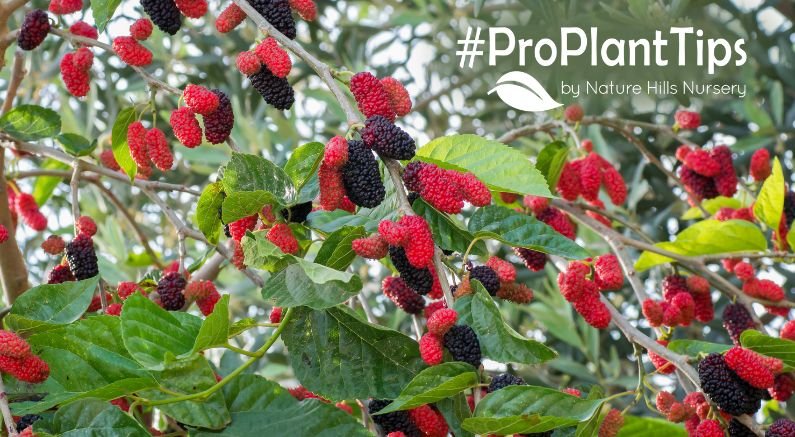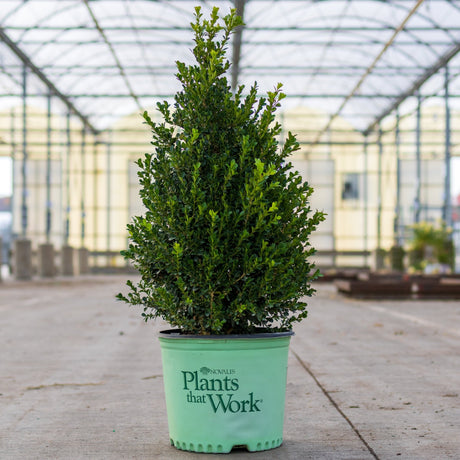 Mulberry trees (Morus) are leafy legends with a long history of feeding both people and wildlife. Their broad, heart-shaped, sometimes lobed or mitten-shaped, and often serrated leaves create a dense canopy of refreshing green shade, while their fast growth makes them one of the quickest ways to establish a cooling presence in the landscape.
Mulberry trees (Morus) are leafy legends with a long history of feeding both people and wildlife. Their broad, heart-shaped, sometimes lobed or mitten-shaped, and often serrated leaves create a dense canopy of refreshing green shade, while their fast growth makes them one of the quickest ways to establish a cooling presence in the landscape.
Cultivated for centuries in Europe, Asia, and the Middle East, Mulberries were valued not only for their fruit but also for their leaves, which remain the sole food source for silkworms.
In the United States, Red Mulberries (Morus rubra) are loved for their hardiness and sweet, dark berries, while White Mulberries (Morus alba) - introduced from Asia - sometimes become invasive due to their ability to naturalize rapidly.
Fruitless Mulberries, on the other hand, deliver lush foliage and cooling shade without the hassle of berry drop. With a mix of fruit-bearing and fruitless choices, Mulberries bring a bold presence, a touch of history, and a bounty of benefits to any landscape.
- Key Features
- Landscaping Uses
- Planting & Care
- Controlling Spread
- Using Mulberries in the Kitchen
- A Berry Good Ending
Mulberry Tree Key Features
- Fast growth - quickly reaches shade size
- Distinct foliage - large, heart-shaped leaves with serrated edges, rich green in summer
- Fruit options - red, black, white, or fruitless
- Wildlife-friendly - berries attract pollinators, birds, and small mammals
- Historic uses - silkworm food, natural dye, traditional medicine
- Tough and adaptable - thrives in sandy, loamy, or poor soils
Landscaping Uses
 Mulberries aren't just about the fruit - they're versatile, shade-giving powerhouses with multiple landscape uses. Their broad crowns create a natural "umbrella" that cools outdoor living spaces, while their berries invite a flurry of wildlife activity. Depending on the variety, Mulberries can be highly functional fruit trees, or they can simply serve as ornamental giants with rich green foliage and long lifespans.
Mulberries aren't just about the fruit - they're versatile, shade-giving powerhouses with multiple landscape uses. Their broad crowns create a natural "umbrella" that cools outdoor living spaces, while their berries invite a flurry of wildlife activity. Depending on the variety, Mulberries can be highly functional fruit trees, or they can simply serve as ornamental giants with rich green foliage and long lifespans.
These trees thrive in open areas where they can spread without interference, and they're just as at home on farms as they are in large residential yards. From privacy screens to play-yard shade, Mulberries bring old-world charm with practical benefits.
- Shade tree - wide canopies cool patios, barns, and yards
- Fruit tree - Red and Black Mulberries deliver tasty summer crops
- Privacy and screening - dense branching blocks the wind, and screens views
- Fruitless options - ideal for parks, ranches, or urban lots without the cleanup
Where NOT to plant Mulberries:
- Near sidewalks, patios and patio furniture, or driveways (fruit stains)
- Next to foundations, septic systems, or paved areas (roots can be invasive)
Planting & Care
 Mulberries are among the easiest trees to grow - they're vigorous, adaptable, and fast to establish. Many varieties shoot up quickly, offering shade within just a few short years. Their toughness in varied soil and weather makes them a great option for both beginner and seasoned gardeners.
Mulberries are among the easiest trees to grow - they're vigorous, adaptable, and fast to establish. Many varieties shoot up quickly, offering shade within just a few short years. Their toughness in varied soil and weather makes them a great option for both beginner and seasoned gardeners.
Planting tips:
- Full sun is best for fruit and strong growth
- Allow 30-50 feet of spread at maturity
- Use arborist mulch to conserve moisture and smother weeds
- Pick a spot with good air circulation to limit mildew
Care basics:
- Prune in late winter to remove dead or crossing branches
- Fertilize in spring with a balanced tree fertilizer
- Water deeply during dry spells, especially during the first 2-3 years
- Protect trunks from lawn equipment damage
Controlling Spread & Suckering
White Mulberries can naturalize quickly and become weedy. Manage seedlings with:
- Raking up and removing dropped fruit promptly
- Mulching beneath the canopy to suppress sprouting
- Pulling up young seedlings before roots establish
- Choosing fruitless Mulberries if you want low-maintenance shade
Using Mulberries in the Kitchen
 Mulberries aren't just for birds and wildlife - they're a tasty treat for people too. The berries can be eaten fresh right off the tree or used in pies, jams, syrups, and smoothies. Their sweet-tart flavor makes them a natural substitute for blackberries or raspberries in recipes.
Mulberries aren't just for birds and wildlife - they're a tasty treat for people too. The berries can be eaten fresh right off the tree or used in pies, jams, syrups, and smoothies. Their sweet-tart flavor makes them a natural substitute for blackberries or raspberries in recipes.
Mulberry leaves have their own culinary uses. Young leaves can be brewed into a mild, earthy tea, and in some cultures, they are used as a leafy green in soups or stir-fries. Their long history in silk production makes them famous, but their place in the kitchen adds another reason to plant one in your garden!
- Red Mulberry Tree - the traditional and widespread, well-known tree
- White Mulberry - a tasty and beautiful white-fruited form
- Fruitless White Mulberry - a great shade tree with no fruit mess
- Fruiting Dwarf Black Mulberry - a dwarf Black Mulberry with juicy, sweet fruit
- Chaparral Weeping Mulberry - a fruiting form with long, weeping branches
A Berry Good Ending!
Mulberry trees are both practical and poetic - fast-growing shade trees with leaves that once fed the silk trade and fruits that still delight birds, children, and gardeners alike!
Yes, they can be vigorous and even a bit messy, but with smart placement and simple care, they'll transform a sunny space into a cool retreat and lively habitat. Few trees combine speed, beauty, history, and productivity quite like the Mulberry.
Happy Planting!



























